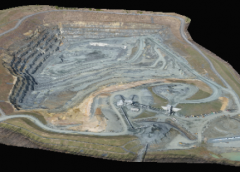The use of drones at aggregates operations is on the rise. They can be used in many applications, from stockpile measuring to quarry face inspection. But figuring out how to use a drone takes time. Learning how to use it comes first, along with safety precautions.
Here are some drone tips and safety tips to help you become a competent drone operator.
1. Register your new drone with the FAA. All new owners of a drone weighing more than .55 grams and less than 55 lb. must register with the FAA’s new Unmanned Aircraft Registration system.
2. Read your drone manual carefully. Each drone is unique and the best way to learn about it is to read the manual.
3. Learn the controls. Mastering the controls is the key to early success with drone piloting.
4. Practice, practice, practice. Getting good with a drone requires practice. Learn what each button and function of your drone does and practice using them together and in combination.
5. Check your drone before you fly. Go through a pre-flight checklist, just like a real pilot.
6. Keep your drone in sight. The golden rule of drone flying is keep your drone in sight. By keeping visual contact, you’ll be able to better see potential obstacles or hazards and find it harder to accidentally fly out of range.
7. Pay attention when you fly. The most common way people crash their drones is by getting distracted while flying.
8. Practice flying without global positioning system (GPS). New drone users should practice flying their drone without the assistance of GPS technology.
9. Educate yourself on the drone laws where you live and prepare for them to change. More than 30 states, as well as the District of Columbia, have drone laws in place. While the FAA has the ultimate authority over drones, it is smart to consult your state laws.
10. Don’t take your drone to crowded public areas. The National Park Service has a drone ban in place, so national parks and monuments are a no-go. Drones are also banned from large public events.
11. Prevent your drone from colliding with a bird. Animals hear different frequencies than humans do. Since birds communicate using sonar, your drone’s visual positioning system could be interpreted by other territorial birds as a sign that it’s moving on their territory.
12. Be careful flying in the wind. Windy days are some of the most difficult conditions to fly in, making it harder to fly with stability or accuracy.
13. For filming, plan your shots before takeoff. Make sure you plan your route and shots before you ever enter the skies. Survey the area you’ll be filming on foot, and plan a sequence based on the environment and your own abilities and equipment.
14. Keep spares on hand. Keep spare parts on hand, so you can make repairs in the field and continue with your planned activities.
15. Do not go to manual mode too fast. Manual mode is meant for expert flyers. When in manual mode, the systems put in place to help make flying easier will not provide the extra stability you need.
Here are some quadcopter safety precautions to keep in mind as well:
- If you’re about to crash into something, turn the throttle down to zero, so you don’t destroy your quadcopter or injure somebody.
- Keep your fingers away from the propellers when they’re moving.
- Unplug and take out the battery of the quad before doing any work on it.
- If you’re a beginner learning to fly indoors, tie the quadcopter down or surround it by a cage.
By keeping these tips in mind, becoming proficient with a drone on the jobsite will happen in no time.
Information for this article from ConExpo-Con/Agg’s Construction & Tech Trends initiative.

